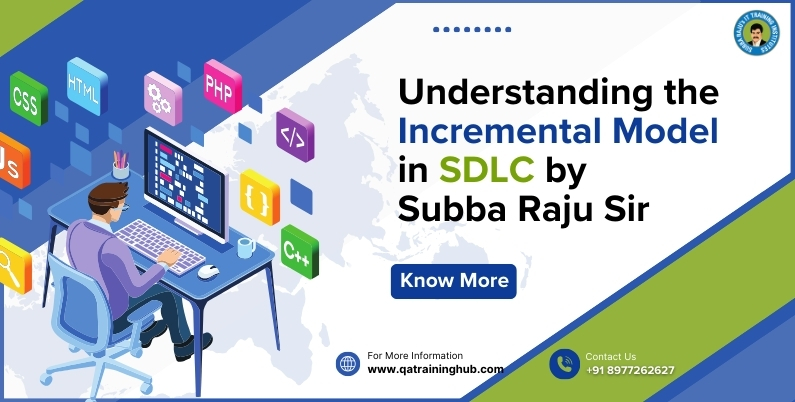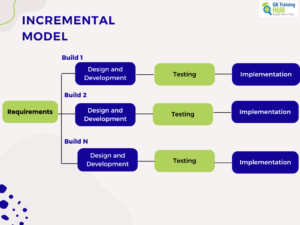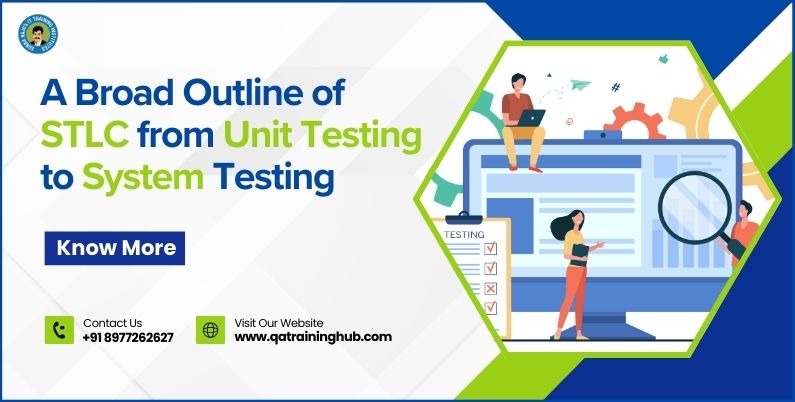Understanding the Incremental Model in SDLC by Subba Raju Sir

The Software Development Life Cycle (SDLC) provides a structured approach to software creation, and among its many models, the Incremental Model is known for its flexibility and efficiency. To meet this challenge, the Software Development Life Cycle (SDLC) offers various models, each designed to optimize the development process. Among them, the Incremental Model stands out for its flexible and phased approach. In the dynamic world of software development, companies are constantly looking for methods to deliver high-quality software quickly and efficiently.. This model is particularly beneficial for projects that require early delivery of functional components and frequent updates based on user feedback. If you’re aiming to become proficient in understanding and applying SDLC models, especially the Incremental Model, getting the right training is crucial. For those based in Hyderabad, SDLC training in Hyderabad offers specialized courses to help students and professionals master the nuances of different SDLC approaches. With the guidance of industry experts, including detailed insights from Subba Raju Sir Videos, this training equips you with the practical knowledge required to excel in today’s competitive software development landscape.
Whether you’re an aspiring developer, a project manager, or someone involved in software quality assurance, understanding the SDLC Incremental Model can provide you with the tools to manage projects more effectively, deliver timely results, and improve client satisfaction.
What is the SDLC Incremental Model?
The SDLC Incremental Model is a method of software development where the product is designed, implemented, and tested incrementally until the entire product is completed. Instead of developing the software in one go, this model breaks down the project into smaller, more manageable parts or “increments.” Each increment adds a functional piece to the system until the final product is achieved.
This model is particularly beneficial when a project needs to deliver early releases of core functionalities and gather feedback for further development. Each increment passes through the standard phases of SDLC, such as requirement analysis, design, implementation, and testing.
Key Features of the Incremental Model
- Phased Development: The system is developed in increments, each building on the previous one.
- Flexibility: It allows for changes and adaptations in the later stages based on feedback or evolving requirements.
- Parallel Workflows: Different teams can work on different increments simultaneously, speeding up the overall process.
- Risk Reduction: Issues or risks are identified early, making it easier to address them without disrupting the entire project.
Why Choose the Incremental Model?
- Early Delivery: Since the initial versions of the software are delivered early, users can start interacting with a basic version of the product, providing valuable feedback.
- Cost-Effective: Incremental delivery helps in managing costs better by focusing resources on building and refining the most critical functionalities first.
- Accommodating Changes: This model is highly adaptive, meaning if business requirements change, the model can accommodate those changes without derailing the entire project.
Phases of the SDLC Incremental Model
- Requirement Analysis: Each increment begins with requirement gathering specific to that phase.
- System Design: Based on requirements, a detailed design for the current increment is created.
- Implementation: The design is translated into code, and the increment is developed.
- Testing: Each increment undergoes rigorous testing to ensure it integrates well with the previous ones and meets the set objectives.
- Delivery and Maintenance: After successful testing, the increment is delivered to the client, and maintenance begins.

Benefits of the Incremental Model in Software Development
- Reduced Complexity: Breaking down the project into smaller increments reduces the complexity of development, making the process more manageable.
- Improved User Feedback: Users can provide feedback after each increment, allowing developers to adjust future increments based on real-world usage.
- Better Risk Management: Since the product is developed in smaller portions, risks associated with each increment can be addressed independently, making the entire project more secure.
Principles of the Incremental Model
The Incremental Model in SDLC follows a set of core principles that differentiate it from other models. Understanding these principles is key to leveraging the model effectively in real-world projects.
- Phased Development: Rather than developing the entire system at once, the project is broken down into smaller, manageable increments. Each phase adds functional components to the product, allowing for staged progress.
- Early Functional Delivery: The Incremental Model allows for the early delivery of core functionalities, enabling users to interact with the product sooner and provide feedback that shapes future increments.
- User Feedback Integration: After each increment is developed and tested, user feedback is gathered and incorporated into subsequent increments, ensuring that the evolving product aligns with client expectations.
- Parallel Workflow: Different teams or developers can work on various increments simultaneously, allowing faster project completion and better resource management.
- Risk Reduction: Dividing the project into smaller phases minimizes risks. Issues or challenges can be identified early in one increment, preventing them from affecting the entire project.
- Flexibility and Adaptability: The model allows for changes in project scope or requirements as the product evolves, making it suitable for projects where requirements may not be fully understood at the outset.
These principles make the Incremental Model ideal for projects that demand flexibility and user-driven enhancements.
Why Learn the SDLC Incremental Model?
Learning the Incremental Model is essential for anyone looking to master software development methodologies. Understanding this model prepares developers, project managers, and stakeholders to efficiently manage projects where flexibility and early delivery are paramount.
For those interested in diving deeper into SDLC models like the Incremental Model, Subba Raju Sir Videos offer comprehensive guidance. His expertise in simplifying complex software development concepts is invaluable for students and professionals alike. Additionally, for those in Hyderabad, SDLC training in Hyderabad offers in-depth courses to master the Incremental Model and other SDLC methodologies, helping you stay competitive in today’s dynamic job market.
Conclusion
The SDLC Incremental Model is a robust and adaptable approach that allows for phased development, providing early functional deliveries and incorporating feedback at each stage. This method minimizes risk, enhances flexibility, and ensures that the end product evolves to meet the user’s needs. By breaking down complex projects into smaller, manageable increments, it not only speeds up the delivery of essential functionalities but also allows teams to adapt to changing requirements without major disruptions.
For professionals and aspiring developers, mastering the Incremental Model can open up opportunities to work on dynamic and evolving projects with a higher success rate. Whether you’re aiming to become a developer, project manager, or part of a quality assurance team, understanding this model is crucial in today’s fast-paced tech environment.
To truly grasp the power of the Incremental Model, it’s essential to undergo proper training. SDLC training in Hyderabad offers in-depth courses that cover the practical and theoretical aspects of this model, equipping you with the tools to apply it effectively in real-world projects. Additionally, Subba Raju Sir Videos provide insightful content, explaining the nuances of SDLC methodologies and offering step-by-step guidance on how to succeed using the Incremental Model.
By gaining expertise in the Incremental Model, you position yourself as a versatile and efficient software professional, capable of delivering high-quality products that align with client expectations and adapt to market changes. Whether you’re just starting out or looking to sharpen your skills, enrolling in SDLC training and learning from industry experts like Subba Raju Sir can propel your career forward, making you a valuable asset in the competitive software development landscape.



